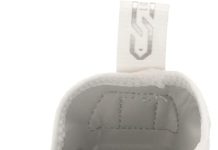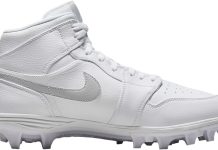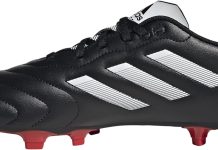In the world of sports footwear, the question of whether soccer cleats are suitable for football has caused quite the buzz. With their sleek design and specialized features, soccer cleats have become a favorite among athletes on the soccer field.
However, many football players are left wondering if these cleats can provide the same level of performance and support on the gridiron.
In this article, we will explore the compatibility of soccer cleats in the world of football, discussing the various factors that come into play when making this crucial decision.
Whether you’re a soccer star looking to dabble in football or a football enthusiast curious about the benefits of soccer cleats, join us as we uncover the truth behind this athletic conundrum.
Difference between Soccer and Football Cleats
Soccer and football are two popular sports that require specific footwear to enhance performance on the field. While both sports involve running and kicking a ball, there are some key differences in the design and functionality of soccer cleats and football cleats.
Review contents
Design
The design of soccer cleats and football cleats differ due to the unique demands of each sport. Soccer cleats typically have a low-cut design with a snug fit around the foot. This design allows for greater maneuverability and quick changes in direction, essential in the fast-paced nature of soccer. On the other hand, football cleats often have a mid-cut or high-cut design to provide additional ankle support and stability during aggressive lateral movements and tackles.
Studs and Traction
Another significant difference is the configuration of the studs or cleats on the sole of the shoe. Soccer cleats usually have smaller, round studs evenly distributed across the outsole for maximum maneuverability and traction on various field surfaces. In contrast, football cleats commonly feature larger, more aggressive studs near the toe and heel, with fewer studs overall. This design helps football players dig into the turf for better traction during explosive movements and sudden changes in direction.
Material
The material used in the construction of soccer cleats and football cleats may also vary. Soccer cleats often have a lighter and more flexible upper, allowing for better ball control and touch. They are commonly made from synthetic materials or a combination of synthetic and leather materials. Football cleats, on the other hand, prioritize durability and protection, favoring sturdier materials like leather or synthetic leather with additional padding to withstand the physical demands of the sport.
Fit and Comfort
Fit and comfort are crucial factors to consider when choosing between soccer cleats and football cleats. Soccer cleats generally provide a snug and anatomical fit to optimize agility and touch, providing a better feel and control of the ball. Football cleats, with their higher-cut designs and added padding, aim to offer more ankle support and protection against impact, albeit sacrificing some flexibility and agility. It is essential to find the right balance between fit, comfort, and the specific demands of the sport you are playing.
Pros and Cons of Using Soccer Cleats for Football
While soccer cleats may seem like a viable option for football players, there are both pros and cons to consider before making the switch.
Pros
Using soccer cleats for football offers several advantages:
Versatility
Soccer cleats are designed for multiple playing surfaces, including grass, artificial turf, and indoor courts. This versatility allows football players to use them on different field types without compromising performance.
Lightweight
Soccer cleats are typically lighter than football cleats, which can provide a performance advantage for some players. The reduced weight may allow for quicker movements, increased agility, and improved sprinting speed.
Availability
Soccer cleats are widely available and come in a variety of styles and price ranges. This allows football players to have a broader selection of footwear options and find a pair that suits their preferences and budget.
Style
Soccer cleats often feature a vast range of eye-catching designs and colors, catering to players who seek to make a fashion statement on the field. Football players using soccer cleats can enjoy the trendier aesthetics offered by soccer footwear.
Cons
Despite the potential upsides, there are some drawbacks to using soccer cleats for football:
Studs
The stud configuration of soccer cleats may not provide optimal traction on certain football surfaces. With smaller round studs, soccer cleats may struggle to grip the field during explosive movements or in slippery conditions, potentially increasing the risk of slips and falls.
Support
Football cleats are specifically designed to provide superior ankle support and stability, vital for absorbing the impact of tackles and sudden directional changes. Soccer cleats, with their low-cut design, lack the same level of ankle support, leaving football players susceptible to ankle injuries.
Protection
Football is a physical sport that involves frequent collisions and tackles. While soccer cleats offer some level of protection, they may not provide the necessary durability and reinforcement required to withstand the rigorous demands of football.
Durability
Due to their lighter construction and focus on agility, soccer cleats may not hold up as well as football cleats over time. The materials used in soccer cleats are often more prone to wear and tear, potentially resulting in a shorter lifespan compared to sturdier football cleats.
Safety Considerations
When considering using soccer cleats for football, it is crucial to take into account the safety considerations associated with this decision.
Ankle Injuries
Football involves frequent lateral movements, sudden stops, and high-impact collisions, putting extra strain on the ankles. Soccer cleats, with their lower-cut design, may not provide adequate ankle support compared to football cleats, increasing the risk of ankle injuries.
Turf vs. Grass
Different playing surfaces can affect the performance and safety of soccer cleats in football. While soccer cleats are designed to provide excellent traction on grass, they may struggle to grip artificial turf, potentially leading to slips and falls.
Player Position
The position a football player occupies on the field may also influence the suitability of soccer cleats. Players in positions that require frequent changes in direction, such as wide receivers and running backs, may benefit from the agility and lightweight nature of soccer cleats. On the other hand, linemen and linebackers, whose movements are more linear and require enhanced stability, may find football cleats more suitable.
Playing Style
Each football player has a unique playing style that may favor one type of cleat over the other. Agile and nimble players who rely on quick movements and finesse may prefer the lightweight and maneuverable nature of soccer cleats. Power players, who rely on raw strength and physicality, may find football cleats better suited to their playing style due to the additional ankle support and stability they provide.
Choosing the Right Soccer Cleats for Football
If you decide to use soccer cleats for football, there are specific features to look for to ensure optimal performance and safety on the field.
Adaptable Studs
Choose soccer cleats with interchangeable studs or cleats that can be adjusted based on the field conditions. This adaptability allows for better traction and grip, regardless of the surface you are playing on.
Ankle Support
Look for soccer cleats with additional ankle support, such as padded collars and lace closures that provide a secure fit around the ankle. This helps minimize the risk of ankle injuries and offers some of the stability and support found in traditional football cleats.
Secure Fit
Ensure that the soccer cleats you choose provide a secure and comfortable fit. Look for cleats with adjustable lacing systems, padded insoles, and anatomical designs that mold to the shape of your foot, optimizing both performance and comfort.
Durable Upper
Football can be a rough and demanding sport, so prioritize soccer cleats with a durable upper made from high-quality materials. Opt for synthetic leather or hybrid constructions that offer a balance between durability and flexibility.
Good Protection
Select soccer cleats with sufficient padding and reinforcement in areas prone to impact, such as the toe box and heel. This added protection helps reduce the risk of injuries and enhances the longevity of the cleats.
Football Cleats vs. Soccer Cleats
Understanding the differences between football cleats and soccer cleats helps determine which footwear to choose for optimal performance.
Design Differences
Football cleats generally have a higher-cut design, offering increased ankle support and stability. Soccer cleats, in contrast, have a lower-cut design that prioritizes agility and maneuverability. The design differences reflect the unique demands of each sport and impact the player’s ability to perform specific movements effectively.
Studs and Traction Differences
Football cleats typically have larger, more aggressive studs concentrated near the toe and heel areas to provide traction during explosive movements. Soccer cleats, on the other hand, have smaller, more evenly distributed studs for maximum maneuverability on various field surfaces. The stud configuration directly affects grip, stability, and the ability to quickly change direction.
Performance Differences
Football cleats are designed to optimize performance in a sport that emphasizes power, speed, and physicality. They prioritize features like ankle support, durability, and traction to meet the demands of the game effectively. Soccer cleats, on the other hand, focus on agility, ball control, and quick movements, catering to the distinctive requirements of soccer.
Price Differences
Football cleats often tend to be more expensive than soccer cleats due to the additional features and construction required to withstand the physicality of the sport. Soccer cleats, with their lightweight and streamlined design, are generally more affordable and accessible for players at all levels.
Rules and Regulations
Before making a decision about using soccer cleats for football, it is crucial to familiarize yourself with the specific rules and regulations of the league or organization you are playing in.
League Rules
Different leagues may have varying rules regarding the type of footwear allowed on the field. Some leagues strictly require football cleats for safety reasons, while others may allow soccer cleats as long as they meet certain criteria. Ensure you are aware of the rules governing your league to avoid potential penalties or restrictions.
Referees’ Decisions
Ultimately, the referees have the final say in deciding whether the footwear you are using is permissible in a football game. Referees will consider factors such as player safety, the condition of the field, and the potential impact on fair play. It is essential to respect their decisions and adhere to their guidance to ensure a fair and safe game.
Professional Footballers’ Preferences
Many professional footballers have chosen to use soccer cleats for football, demonstrating that it can be a viable option even at the highest level of the sport.
Famous Players Using Soccer Cleats for Football
Some notable footballers, such as Cristiano Ronaldo and Lionel Messi, have utilized soccer cleats throughout their careers, excelling on the football field despite the unconventional footwear choice. Their success showcases that individual preference and playing style can sometimes supersede traditional norms.
Reasons for Their Preferences
Professional players who opt for soccer cleats in football often do so due to the lightweight and agile nature of these shoes. The increased maneuverability allows them to showcase their dribbling skills, quick changes in direction, and superior ball control. These players prioritize speed, agility, and finesse, utilizing the advantages provided by soccer cleats to enhance their performance on the field.
Conclusion
While soccer cleats may not be the traditional choice for football players, they can offer certain advantages when used appropriately. The design, stud configuration, and fit of soccer cleats differ from those of football cleats, impacting performance, stability, and protection.
Understanding the differences between soccer cleats and football cleats, as well as considering personal playing style and safety considerations, can help determine whether using soccer cleats for football is a suitable option for individual players. Regardless of the cleats chosen, it is essential to prioritize safety, comfort, and the specific requirements of the sport to maximize performance and enjoyment on the football field.





































